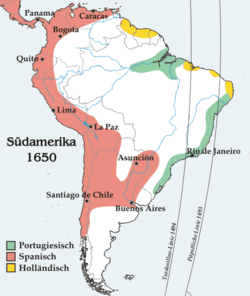
Back إنتر كايتيرا Arabic Inter caetera Byelorussian Butlla menor Inter Caetera de 1493 Catalan Inter caetera Czech Inter caetera German Inter caetera Esperanto Bula menor Inter caetera de 1493 Spanish Inter caetera French אינטר קאטרה HE Inter caetera ID

Inter caetera ('Among other [works]') was a papal bull issued by Pope Alexander VI on the 4 May 1493, which granted to the Catholic Monarchs King Ferdinand II of Aragon and Queen Isabella I of Castile all lands to the "west and south" of a pole-to-pole line 100 leagues west and south of any of the islands of the Azores or the Cape Verde islands.[1]
It remains unclear whether the pope intended a "donation" of sovereignty or an infeudation or investiture. Differing interpretations have been argued since the bull was issued, with some arguing that it was only meant to transform the possession and occupation of land into lawful sovereignty. Others, including the Spanish crown and the conquistadors, interpreted it in the widest possible sense, deducing that it gave Spain full political sovereignty.[2]
Inter caetera and its supplement Dudum siquidem (September 1493) are two of the Bulls of Donation.[3] While these bulls purported to settle disputes between Spain and Portugal, they did not address the exploratory and colonial ambitions of other nations, which became more of an issue after the Protestant Reformation.
- ^ A single meridian is excluded because no lands can be south of it. Two partial meridians are possible, one extending north from a point west of the Azores and another extending south from a point south of the Cape Verde Islands, the two being connected by a north-northwest south-southeast line segment. Another possibility is a rhumb line west and south of the islands extending north-northwest and south-southeast. All rhumb lines reach both poles by spiraling into them.
- ^ Verzijl, Jan Hendrik Willem; W.P. Heere; J.P.S. Offerhaus (1979). International Law in Historical Perspective. Martinus Nijhoff. pp. 230–234, 237. ISBN 978-90-286-0158-1.. Online, Google Books entry
- ^ "The Möbius strip: a spatial history of colonial society in Guerrero, Mexico", Jonathan D. Amith, p. 80, Stanford University Press, 2005 ISBN 0-8047-4893-4
© MMXXIII Rich X Search. We shall prevail. All rights reserved. Rich X Search